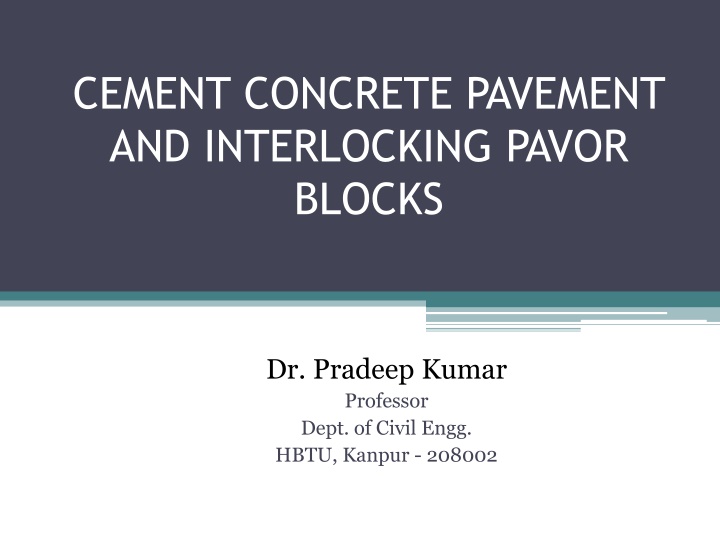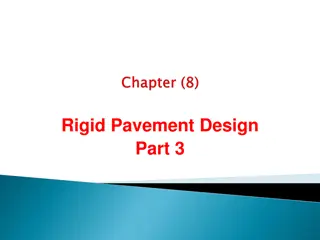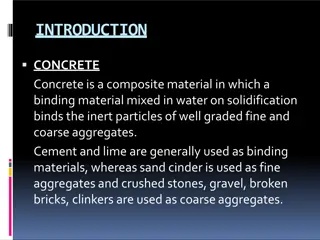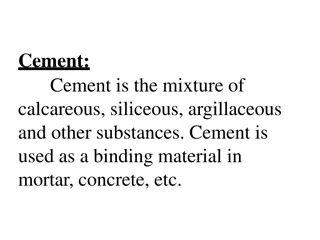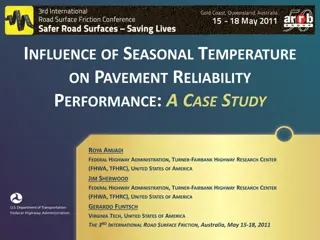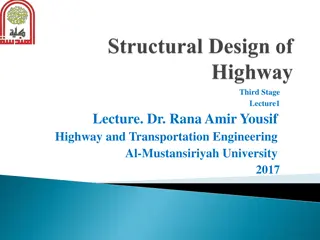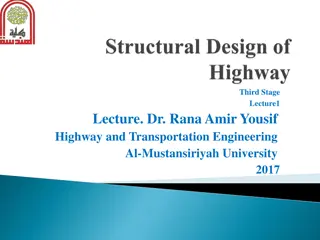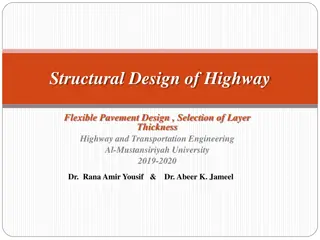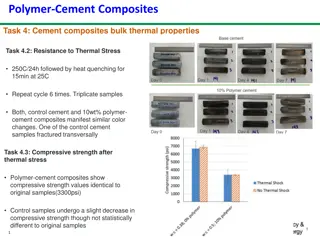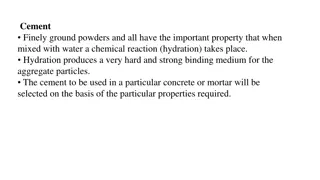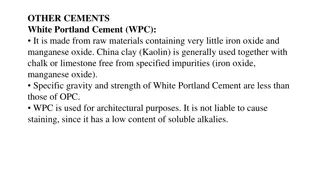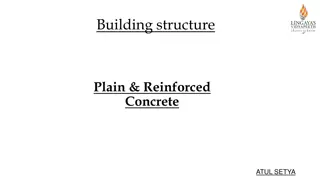Guidelines for Design of Cement Concrete Pavement and Interlocking Paver Blocks
This document provides guidelines for designing cement concrete pavements and interlocking paver blocks, covering factors governing design, wheel loads, design period, subgrade characteristics, approximate k values based on CBR values, and the importance of a sub-base below concrete pavements. It emphasizes considerations such as wheel loads, design life, subgrade strength, and sub-base materials to ensure durability and stability. The content highlights design principles for rural roads and offers insights into achieving a minimum 20-year design life for concrete pavements.
Download Presentation

Please find below an Image/Link to download the presentation.
The content on the website is provided AS IS for your information and personal use only. It may not be sold, licensed, or shared on other websites without obtaining consent from the author.If you encounter any issues during the download, it is possible that the publisher has removed the file from their server.
You are allowed to download the files provided on this website for personal or commercial use, subject to the condition that they are used lawfully. All files are the property of their respective owners.
The content on the website is provided AS IS for your information and personal use only. It may not be sold, licensed, or shared on other websites without obtaining consent from the author.
E N D
Presentation Transcript
CEMENT CONCRETE PAVEMENT AND INTERLOCKING PAVOR BLOCKS Dr. Pradeep Kumar Professor Dept. of Civil Engg. HBTU, Kanpur - 208002
Wheel Load The legal axle load in India being 102 Kn. The pavement may be designed for a wheel load of 51 kN. However, for link roads serving isolated villages Where the traffic consists of agricultural tractors and trailers and light commercial vehicles only, a design wheel load of 30 kN may be considered. Tyre Pressure The tyre pressure may be taken as 0.7 MPa where a wheel load of 51 kN is considered and 0.5 MPa where a wheel load of 30 kN is considered.
Design Period The design methodology given in these guidelines is based on wheel load stresses. The repetitions of wheel loads and the consumption of fatigue, which form the basis of design in IRC:58-2012, need not be considered for the very low volume of traffic encountered on rural roads. Concrete pavements designed and constructed as per the guidelines contained in this document will have a design life of not less than 20 years, as evidenced from the constructed in the past in the country. performance of roads
Characteristics of the Subgrade The strength of subgrade is expressed in terms of modulus of subgrade reaction, k, which is determined by carrying out a plate bearing test, using 750 mm dia. Plate according to 18:9214-1974. In case of homogeneous foundation, test values obtained with a plate of 300 mm dia, k300, may be converted to give k750, determined using the standard 750 mm dia. plate by the following correlation: k750= 0.5 k300... ... ... (1) Since, the subgrade strength is affected by the moisture content, it is desirable to determine it during or soon after the rainy season. An idea of the k value of a homogeneous soil subgrade may be obtained from its soaked CBR value using the following table.
Approximate k values corresponding to CBR values 2 3 4 5 Soaked CBR% K value n/mm2/mm 7 10 15 20 50 21 28 35 42 48 50 62 69 140
Sub-Base The provision of a sub-base below the concrete pavement has many advantages such as: It provides a uniform and reasonably firm support It prevents mud-pumping on sub grade of clays and silts It acts as a levelling course on distorted, non-uniform and undulating sub-grade It acts as a capillary cut-off Where the pavement is designed for a wheel load of 51 kN, a 150 mm thick sub-base of Water Bound Macadam (using 53-22.4 mm aggregates), granular sub-base, gravel, soil-cement or soil-lime may be provided. Where the traffic is light and the pavement is designed for a wheel load of 30 kN, the thickness of the sub-base may be reduced to 75 mm. The WBM and granular sub-base surface shall be finished smooth. When the above type of sub-base is provided, the effective k value may be taken as 20 per cent more than the k value of the sub-grade. A plastic sheet of 125 microns thickness shall be provided over the sub-base to act as a separation layer between the sub-base and concrete slab
Concrete Strength Since concrete pavements fail due to bending stresses, it is necessary that their design is based ;>n the flexural strength of concrete. Where there are no facilities for determining the flexural strength, the mix design may be carried out using the compressive strength values and the following relationship: f= 0.7fc0.5 where, f= flexural strength, N/mm2 f c = characteristic compressive cube strength, N/mm2 If the flexural strength observed from laboratory tests is higher than that given by the above formula, the same may be used. For Rural Roads, it is suggested that the 90-day strength be used for design instead of the 28-day strength as the traffic develops only after the lapse of a period of time. The 90 day flexural strength may be taken as 1.20 times the 28-day flexural strength or as determined from laboratory tests. Heavy traffic should not be allowed for 90- days
The concrete mix should be so designed that the minimum flexural strength requirement in the field is met at the desired confidence level. For rural roads, the tolerance level (accepted proportion of low results), can be taken as 1 in 20. The normal variate, Z , for this tolerance level being 1.65, the target average flexural strength is obtained from the following relationship: S = S1+ Za Where, S = target average flexural strength at 28 days MPa S1= charachteristic flexural strength at 28 days MPa. Za= normal variate, having a value of 1.65, for a tolerance factor of 1 in 20. a = expected standard deviation of field test samples, MPa
Table 2: Expected values of standard deviation of compressive strength Grade of concrete Standard deviation for different degrees of control, Mpa Very good Good 5.0 6.0 5.3 6.3 5.6 6.6 Fair 7.0 7.3 7.6 M30 M35 M40 The standard deviation of flexural strength may be derived approximately using the formula given earlier. For pavement construction for rural roads, it is recommended that the characteristic 28-day compressive strength should be at least 30 MPa. The characteristic 28-day flexural strength shall be at least 3.8 MPa
Modulus of Elasticity and Poisson's Ratio The Modulus of Elasticity, E, of concrete may be taken as 3.0 x 104 MPa. The Poisson's ratio may be taken as 0.15. Coefficient of Thermal Expansion The coefficient of thermal expansion of concrete , may be taken as cc=10x10-6 per C
Calculation of Stresses Edge Stresses: (a) Due to load: The load stress in the critical edge region may be obtained as per Westergaard analysis as modified by Teller and Sutherland from the following correlation (metric units): P I le = 0.529 (l+0.54fi)(41og 10 +log ]0 b-0.4048) ... ... (3) where, le = load stress in the edge region, MPa P = design wheel load, N h = pavement slab thickness, mm = Poisson's ratio for concrete E = Modulus of elasticity for concrete, MPa k = Modulus of subgrade reaction of the pavement foundation
(b) Due to temperature: The temperature stress at the critical edge region may be obtained as per Westergaard's analysis, using Bradbury's coefficient from the following correlation: te = E x t where, te = temperature stress in the edge region, MPa t = maximum temperature differential during day between top and bottom of the slab, C a = Coefficient of thermal expansion of concrete, C C = Bradbury's coefficient, which can be ascertained directly from Bradbury's chart against values of L/l and W/l L = slab length or spacing between consecutive contraction joints, m W = slab width, m I = radius of relative stiffness, m
Temperature differential: Temperature differential between the top and bottom of concrete pavements causes the concrete slab to warp, giving rise to stresses. The temperature differential is a function of solar radiation received by the pavement surface at the location, losses due to wind velocity, etc., and thermal diffusivity of concrete, and is thus affected by geographical features of the pavement location. As far as possible, values of actually anticipated temperature differentials at the location of the pavement should be adopted for pavement design. Corner stresses: The load stress in the corner region may be obtained as per Westergaard's analysis as modified by Kelley, from the following correlation : where, lc = 3P/h^2[1-{a(2)^1/2/l}^1.2] lc= load stress in the corner region, other notations remaining the same as in the case of the edge stress formula.
RECOMMENDED TEMPERATURE DIFFERENTIALS FOR CONCRETE SLABS Zone States Temperature differentials 150 mm 200 mm 250 mm I Punjab, UP, UK, Rajasthan, Haryana, Gujrat, MP Bihar, Jharkhand, WB, Assam, Odisha Maharashtra, Karnataka, Chatisgarh, AP Kerala, Tamil Nadu 12.5 13.1 14.3 II 15.6 16.4 16.6 III 17.3 19.0 20.3 IV 15.0 16.4 17.6 V Coastal Areas bounded by hills Coastal Areas unbounded by hills 14.6 15.8 16.2 VI 15.5 17.0 19.0
Types of joints Rural Roads are generally of single-lane, and the full lane width (3.0 m-3.75 m) is concreted in one operation. Thus, there is no need for a longitudinal joint for single-lane rural roads. As regards transverse joints, they are of three types: 1. Contraction joints 2. Construction joints 3. Expansion joints
Spacing of joints Transverse contraction and construction joints: The spacing of transverse contraction joints or construction joints in alternate bay construction may be kept 2.50 m-3.75 m. The length of the panel (in the direction of traffic) shall not be less than the width of the panel. Expansion joints: Expansion joints are necessary where concrete slabs abut with bridges and culverts. Longitudinal joints: Where the width of concrete slab exceeds 4.5 m as in the case of causeways, etc., it is necessary to provide a longitudinal joint as per the details given in Fig. 6 in the mid-width of the slab.
Load transfer at Transverse joints Since rural roads have low traffic with small wheel loads, the slab thickness normally being 150-250 mm, the aggregate interlock at the sawn joints is itself adequate for load transfer and no dowel bars are necessary. If slabs are cast in alternate panels, keyed joints can be formed. Day's work should normally be terminated at a contraction joint. At expansion joints, where the joints width may be 20 mm, dowel bars are required Dowel bars shall be 25 mm diameter, 500 mm long and spaced at 250 mm centre to centre. In the case of Roller Compacted Concrete Pavements, the contraction joints may be formed by cutting joints with concrete saw at the spacing. If aesthetics of the road is not an important consideration, the sawing of joints may be omitted and the cracks allowed to form on their own.
ILLUSTRATIVE EXAMPLE OF DESIGN OF A CEMENT CONCRETE PAVEMENT FOR RURAL ROADS
Example A cement concrete pavement is to be designed for a rural road in Uttar Pradesh having a traffic volume of 150 vehicles per day consisting vehicles like agricultural tractors/trailers, light good vehicles, heavy trucks, buses, animal driven vehicles, motorized two wheels and cycles. Design the pavement. The soil has a soaked CBR value of 4.
Design Wheel load As per para 3.1, the wheel load appropriate for the traffic conditions is 51 kN. k value From Table 1, the k value corresponding to a CBR value is 4 is 35 10-3 N/mm2/mm. Sub-base Provide a 75 mm thick WBM course. Effective k Value Since a sub-base is provided, the k value can be increased by 20% (para 2.5). Effective k value = 1.20 35 10-3 = 42 10-3 kg/mm2/mm.
Concrete Strength Adopt a 28 day compressive strength of 30 Mpa. Flexural strength ff = 0.7 fc = 3.834 Mpa. So, 28 day flexural strength = 3.834 Mpa. 90 day flexural strength = 1.20 3.834 Mpa = 4.6 Mpa Thickness Try a thickness of 150 mm. Edge Load Stress From fig.4, keff= 42 10 -3 N/mm3, edge load stress is 4.5 MPa
Temperature Stress From Table 4, the temperature differential for U. P. for a slab thickness of 150mm is 12.5 C. Assuming a contraction joint spacing of 3.75 m and 3.75 m width, the radius of relative stiffness l, is as under: L = 3750 mm B = 3750 mm l = radius of relative stiffness = E = 3 104 N/mm2 h = 150 mm = 0.15 k = 42 10-3 N/mm2/mm l = putting values in the above formula = 673.3 mm L/l = 3750/673.3 = 5.57 W/l = 3750/673.3 = 5.57 Both values are same, For L/l = 5.57, Bradbury s coefficient C = 0.834
Using chart in Fig. 6, te = 1.6 Mpa Total Stress = Edge Load Stress + Temperature Stress = 4.5 + 1.6 = 6.1 Mpa This is greater than allowable flexural strength of 4.6 Mpa. So thickness of 150 mm assumed is inadequate. Try a thickness of 190 mm. Edge Load Stress From fig. 4, edge load stress le = 2.9 Mpa. Temperature Stress From Table 3, the temperature differential for U. P. for a slab thickness of 200 mm is 13.1 C. Radius of relative stiffness l = Putting the values in the above equation; l = 804 mm L/l = 4.66 W/l = 4.66
Both values are same, For L/l =4.66, Bradbury s coefficient = 0.0625 Using chart at fig.1 Temperature stress, te = 1.41 Mpa Total Stress = 2.9+1.41 = 4.31 Mpa The total stress is less than 4.6 Mpa and hence assumed thickness of 190 mm is OK. Corner Stress From fig. 5, corner load stress for wheel load of 51 kN, k = 42 10-3 N/mm2/mm and slab thickness of 190 mm Corner stress, lc = 2.9 Mpa. Since the corner stress is less than 4.6 Mpa and hence the thickness of 190 mm is SAFE.
IRC SPECIFICATIONS FOR INTERLOCKING CONCRETE BLOCK PAVEMENTS
Scope Interlocking concrete block pavements have been used extensively in a number of countries for quite sometime. Considering their advantages and potential for use, the guidelines have been prepared for design and construction of such pavements, giving the suggested catalogues, construction specifications for their use. applications, practices design and
Applications Footpaths and side walks Cycle tracks Residential streets Car parks Fuel stations Rural roads through villages Highway rest areas Toll plaza Bus depots Approaches to railway level crossings Intersections City streets Truck parking areas Industrial floors Urban sections of highways Urban sections of highway Road repairs during Monsoons Container depots Port wharf and Roads Roads in high altitudes areas
Advantages Since the blocks are prepared in the factory, they are of a very high quality, thus avoiding the difficulties encountered in quality control in the field. Concrete block pavements restrict the speed of vehicles to about 60 kmph, which is an advantage in cities and intersections. Due to rough surface these pavements are skid resistant. The block pavements are ideals for intersections where speeds have to be restricted and cornering stresses are high.
The digging and reinstatement of trenches for repairs for utilities is easier in the case of block pavements. They are unaffected by the spillage of oil from vehicles, and are ideal for bus stops, bus depots and parking areas. They are preferred in heavily loaded areas like container depots and ports as they can be very well designed to withstand the high stresses induced there. In India, the laying of concrete block can be achieved at a very low cost due to availability of cheap labour.
Since they are grey in colour, they reflect more light than the black bituminous pavements thus reducing the cost of street lightning. The cost of maintenance is much lower than the bituminous pavements. Block pavements do not need in-situ curing so they can be opened to traffic soon after the completion of construction. Construction is simple and labour-intensive, and can be done using single compaction equipment.
Structurally round blocks can be recycled many times over. Block deterioratory effect due to thermal expansion and contraction and are free from cracking phenomenon. pavements does not exhibit very Use of permeable block pavements in cities can help replenish depleting underground source of water, filter pollutants before they reach open water sources, help reduce storm water runoff and reduce the quantum of water drainage structures.
Limitations Concrete block pavements cannot be used for high speed facilities. The riding quality is reasonably good for low speed traffic, but is inferior to that observed on a machine laid bituminous or concrete pavement. The noise generated is high, 5-8 dB (A) higher than bituminous surfaces. A very good attention to pavement drainage is needed because the water seep through the joints.
TYPES AND SHAPES OF BLOCKS
The blocks can be interlocking horizontally and vertically as shown alongside:
Present day interlocking blocks have evolved in shape after observing their performance. The rectangular shape is shown alongside. It was intended for imitating the stone set blocks.
This is an improved version with many dentated faces for better contact and interlocking effect resulting in enhanced friction with the adjoining block. It also increases the shear strength of the block system and hence load dispersal capacity.
This block is a further improvement over dentated rectangular block.
The dentated blocks can be further grouped as shown in the figure into three categories: Category A: Dentated units are designed to key into each other on all four faces and which, by their plan geometry when keyed together, resist the widening of the joint. These blocks can be laid in herringbone bond pattern.
Category B: These blocks are dentated only on two sides. Their dimensional accuracy of laying helps in bringing about the interlock effect on other faces. Generally, with some exceptions, these blocks can only be laid in stretcher bond.
Category C: These are not dentated type but depend on dimensional accuracy for interlocking effect. These blocks can be laid only in a stretcher bond.
DIMENSIONS Top surface area : 5,000 to 60,00o mm2. Horizontal dimension not exceeding : 28 cm. 1<(Mean length/Mean width)<3 Thickness : Between 60 to 140 mm Length/Thickness : 4
COMPOSITIONOFBLOCK PAVEMENT Except for the top wearing part of the pavement; the base and sub base layers are similar to the conventional flexible or rigid pavement. Depending on the load coming on them, the composition of the pavement differs.
Typical pavement composition A few typical composition normally used are given in figure.
Block Thickness Interlocking concrete blocks come in different thicknesses. These blocks serve as wearing surface but at the same time help in reducing the stresses imposed on subgrade and also help in resisting pavement deformation and elastic deflections similar to the base course of the flexible pavement.
For category A blocks used for light traffic, such as, pedestrains , motor cars cycles, etc.,a block thickness of 60 mm is adequate ; for medium traffic ,a thickness of 80 mm is generally used ; for heavily traffic roads, Category B blocks of the thickness 100-120 mm are used. Thick blocks are best suited where high volumes of turning movements are involved .
